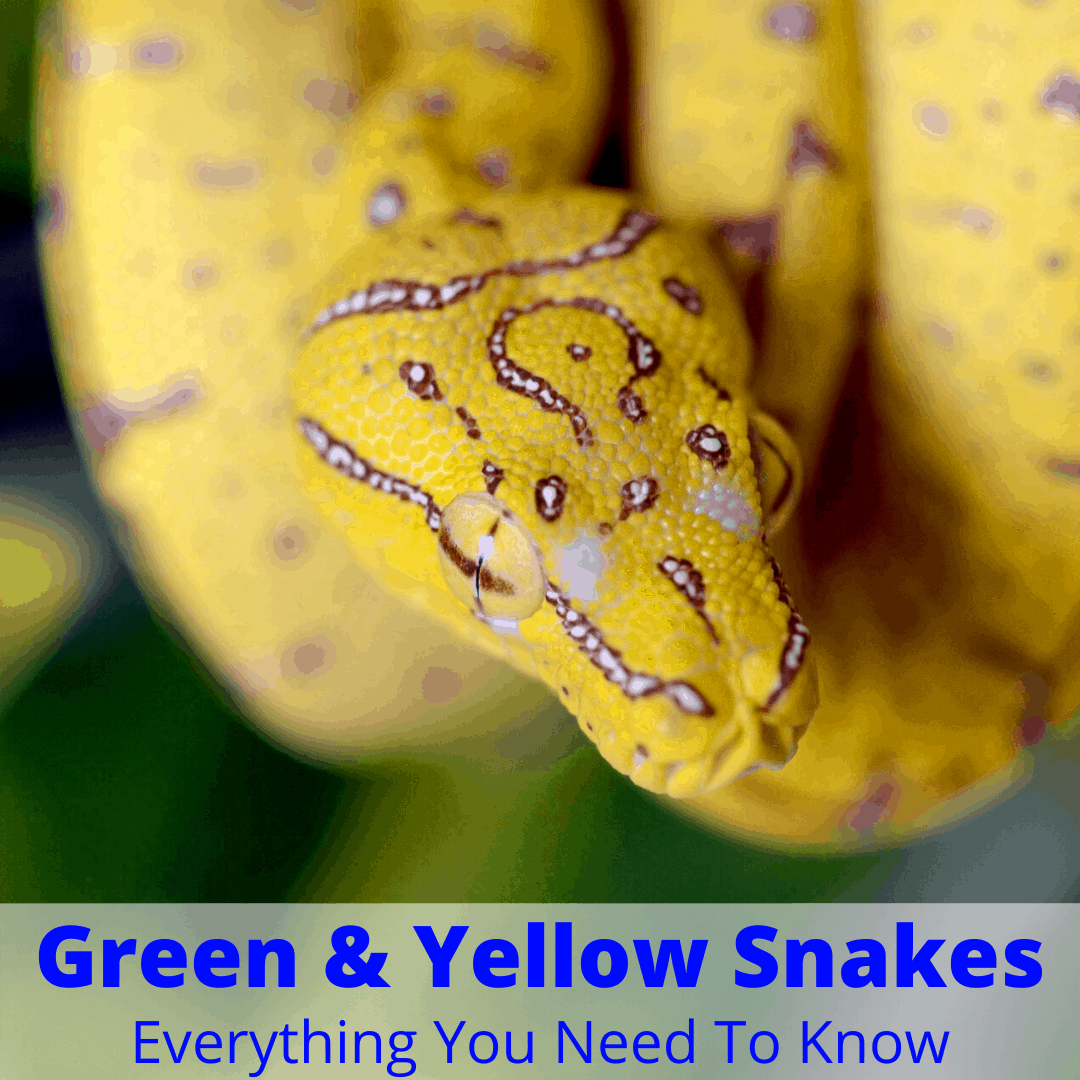
And some of them are deadly, most notably the infamous and highly venomous green mamba.
Green snakes live on all continents, but yellow snakes are more rare.
If you saw a green or yellow snake and are wondering what it is, you are in the right place.
We’ll cover the most common yellow and green snakes below, especially the venomous ones. That way you can hopefully at least know if the snake you saw poses a danger to you.
We’ll start with green snakes and then cover the few common yellow snakes.
Table of Contents
Green And Yellow Snakes
Green snakes belong to the snake family Colubridae, named for their color. Some of these green snakes are docile and harmless and can be found in our gardens.
They are often nondescript, shy, nervous and inoffensive, trying to move away quickly as soon as they are detected.
There isn’t a snake called the Yellow snake, but the term ‘yellow snakes’ could refer to a number of different species, like the yellow rat snake from the colubrinae family, for instance.
The best way to identify yellow snakes is to look for other unique characteristics apart from the yellow scales.
Green and yellow snakes are common around the world. Some are venomous and some are non-venomous. All of them will only strike out if you try to catch or kill them, or threaten them in some way.
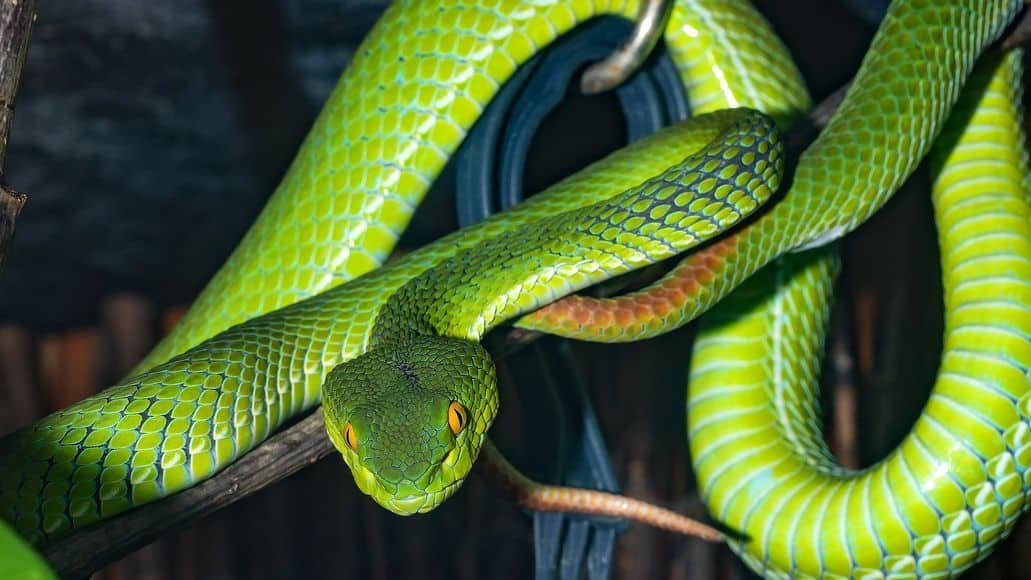
Location Gives Tips As To The Type Of Snake It Is
You might see two similar looking snakes, but one can be venomous and the other not. The location where you saw the snake is usually a big help in determining the type of green snake or yellow snake it could be.
If you see green and yellow snakes in your garden, it helps to know what snakes exist in your area. That will greatly narrow down what species it could be, but it is not certain that it’s one of those.
There is always the possibility that a neighbor has imported a snake from elsewhere and not told anyone.
Let’s take a look at some common species of green or yellow snakes.
Types Of Green Snakes Around The World
We’ll list some of the most common green snakes around the world, focusing on the most beautiful and the ones you are most likely to encounter. Below that, we’ll briefly cover yellow snakes.
African Green Snakes
Spotted Bush Snake – Exquisite And Harmless
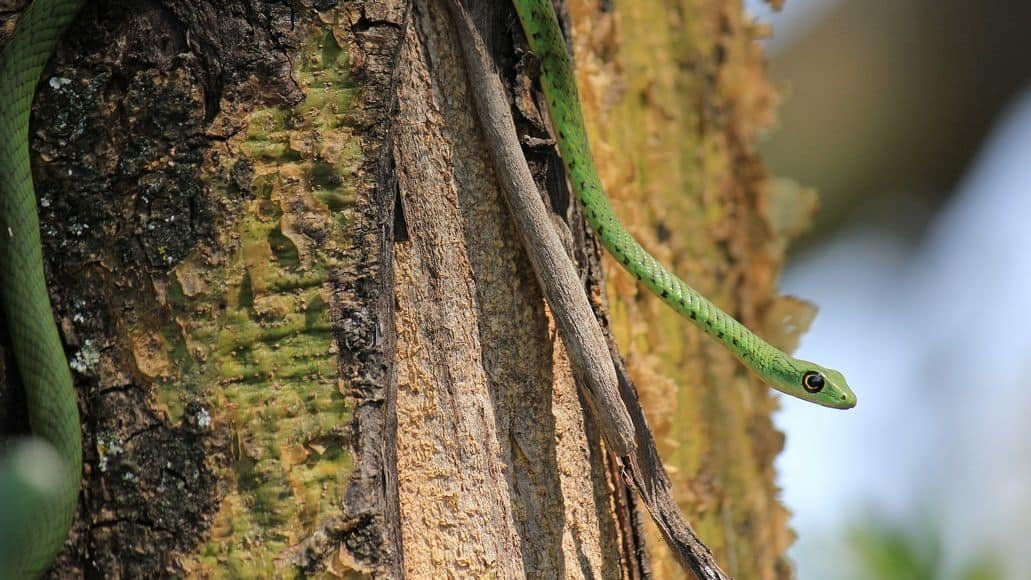
The slender Spotted Bush Snake with its orange eyes is a beautiful harmless green snake in South Africa. Its a bright green snake with a distinct black pattern.
It is commonly referred to as ‘The Garden Snake’ – a snake is frequently seen in and around homes.
The best thing to do when you see this snake is just to let it slither away by itself. They’re not out to get you and are merely on the lookout for their favorite food – geckos.
It’s such a beautiful snake it would be a sin to kill it, especially since it is harmless.
Alert and active during the day, this green snake comes into the suburbs, often found in outbuildings where it hunts for geckos. Such a harmless snake is a pleasure to have in your garden.
If you’re unsure about a snake’s identity, it is best to call a snake expert out to your property to have the snake identified and removed.
Because you don’t want to get too close to the next one.
Venomous Green Mamba
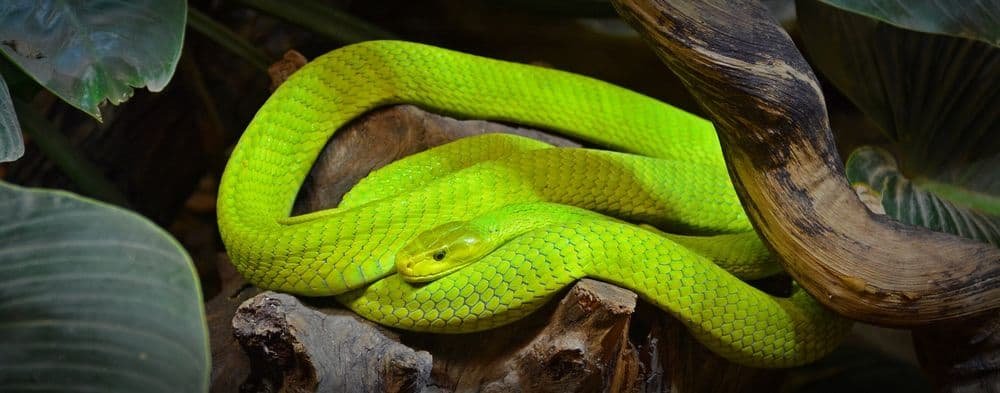
In KwaZulu Natal, South Africa, green snakes in your garden are likely to be harmless. There is, however, also the Green Mamba which can grow to lengths of 2.5 meters, making it one of the biggest snakes in Africa.
It is a beautiful, lime-green snake that spends most of its time in the foliage of a tree. This is where it’s at home, and it is spectacularly camouflaged among the leaves where it hunts for prey such as birds, lizards, and small mammals.
It is shy and nervous and tries to avoid humans. It is capable of injecting high quantities of venom, and without immediate medical help, mortality rates are high.
Green House Snake
The Green House Snake is always a favorite among snake enthusiasts in South Africa. Over the last few years, there have been quite a few new morphs emerging from these house snakes and there is also a potential for even more new color mutations to be developed.
There are different color varieties of house snakes and this comes down to locality and species. Most are shades of brown, but there are other color varieties that have been bred such as the red and green.
The Aurora House Snake, as it is also known, is a beautiful, harmless snake that likes grasslands, feeding on mice, lizards, frogs, and birds. It’s a shy snake that emits a foul-smelling musk smell when handled.
Bush Viper
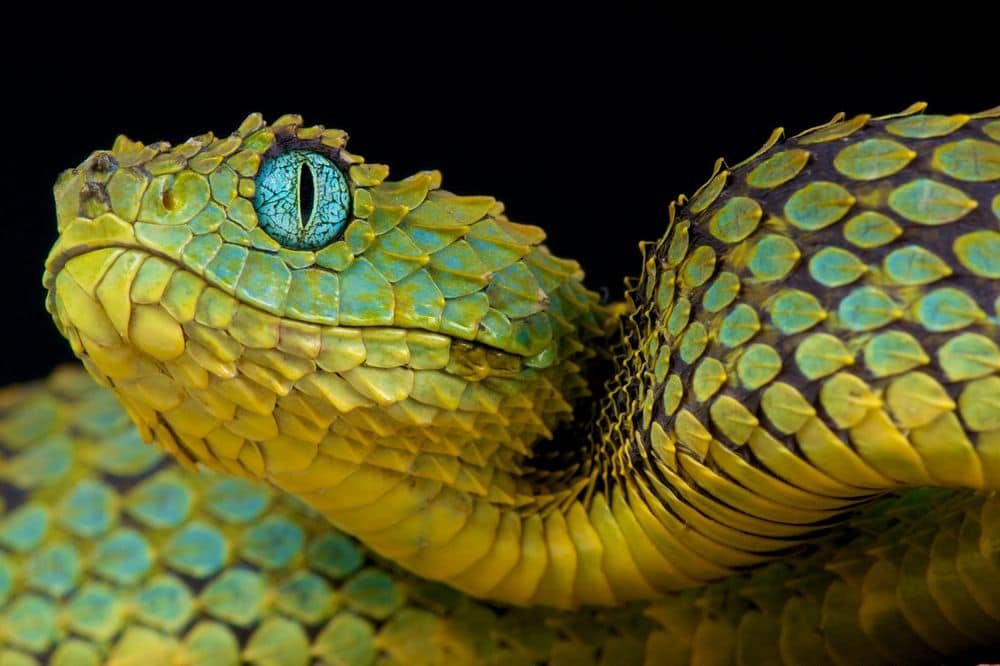
Sometimes also known as the snake that looks like a dragon, the bush viper is a unique looking snake. It can come in a variety of colors, but green is the most common.
The bush viper is a highly venomous snake that lives in most humid parts of sub-Saharan Africa. If is an arboreal snake, which means it likes to hang out in trees.
A bush viper’s eyes are unusual too. They generally have the same color as the body, with a horizontal pupil. Horizontal pupils are not uncommon in snakes, but the varying colors are what landed the bush viper a spot on our list of the snake species with the strangest eyes.
Angola Green Snake
If you were to meet the emerald green colored Angola Green Snake, you couldn’t be blamed for thinking that you’ve come across the Green Mamba.
It is found in parts of Namibia, northern Botswana, Zimbabwe and Mozambique and along the Mozambique/South African border. It is seldom seen in South Africa.
The harmless Angola Green Snake is an egg-laying snake. It has yellow eyes and is a more robust and stockier snake than the Mamba. It reaches a height of about 3 feet.
When the snake becomes agitated, it puffs out the skin on the neck to reveal yellow speckling. It likes to hang out along river banks and among reeds.
It can swim well and it feeds on frogs, lizards, and birds. The snake, in turn, is eaten by other snakes as well as predatory birds.
Asia
Asian Lancehead
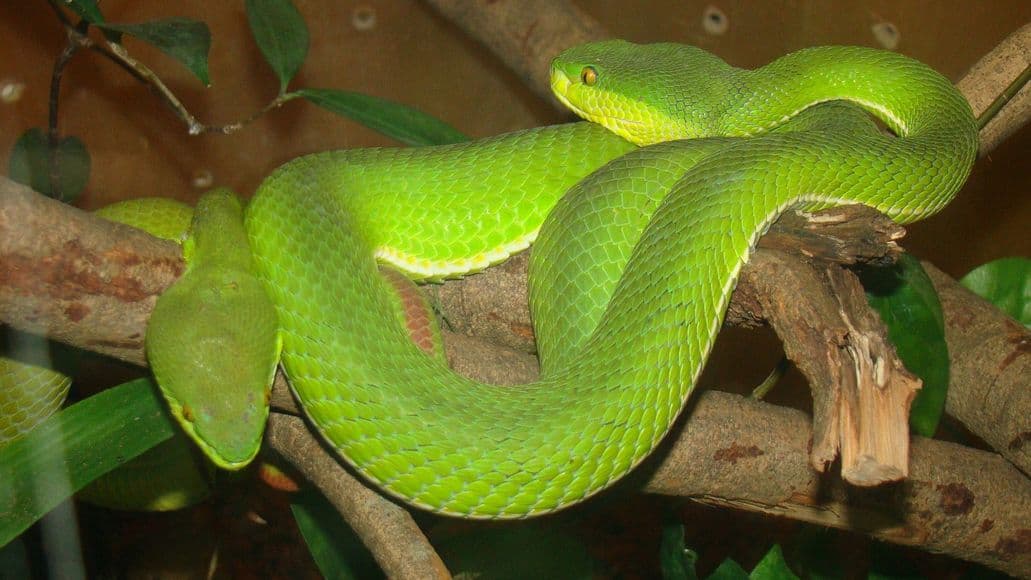
Many green colored snakes cause fatalities each year in Asia. The most common is the Asian Lancehead, which is a pit viper with a triangular shaped head. Like all vipers, it is venomous.
Green Tree Python
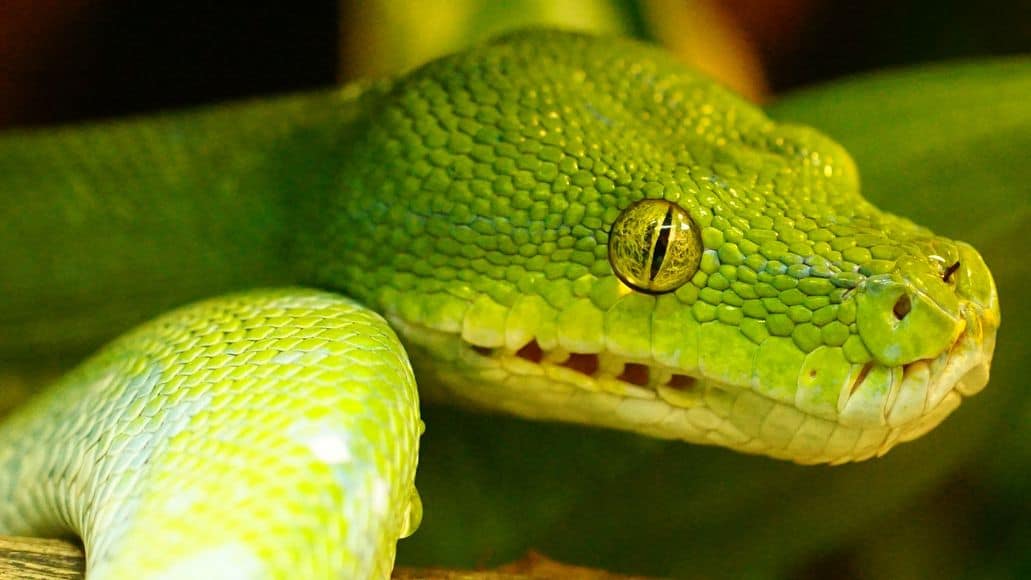
The green tree python is a non-venomous constrictor. It has distinctive heat-sensing pits underneath its lower lips that can sense warm-blooded animals. It spends most of its time hanging on branches waiting until it senses prey, then grabbing it and crushing it.
This green snake lives primarily in New Guinea and Indonesia, but can also be found in the very north of Australia. They have a large bright green body with white spots. Young snakes can also be yellow or red with white spots.
Australia
Australia is known for its venomous snakes, and they have one or two green snakes. The venomous Tiger snake can be brown or green, according to the region they are found.
Their venom contains neurotoxins, affecting the nervous system. A bite from one of these serpents is considered a medical emergency.
North America
There are just so many snakes that are green in color. While there are a good number of green snakes that are venomous on the African continent, the only North American venomous snakes that have a bit of green color are the cottonmouths and Mojave Rattlesnakes.
This greenish hue is actually the main difference between mojave rattlesnake and western diamondback rattlesnake species, in terms of being able to tell them apart.
When you move down to Central America and Mexico, you get the palm pit vipers of which there are quite a few species, and most are bright green.
There are a umber of non-venomous snakes in the northern areas, however, like the rough green snake.
Rough Green Snake
The Rough Green Snake is common throughout the southeastern United States – areas with lots of vegetation.
It’s a slim, grass-green colored arboreal snake, spending its time in trees. They don’t have venom and they kill their prey by constriction.
Palm Pit Viper
There are a number of pit viper species in Central America, like the Guatemala palm pit viper and the Mexican palm pit viper. These palm vipers have triangular shaped heads and are venomous. A bite can be fatal.
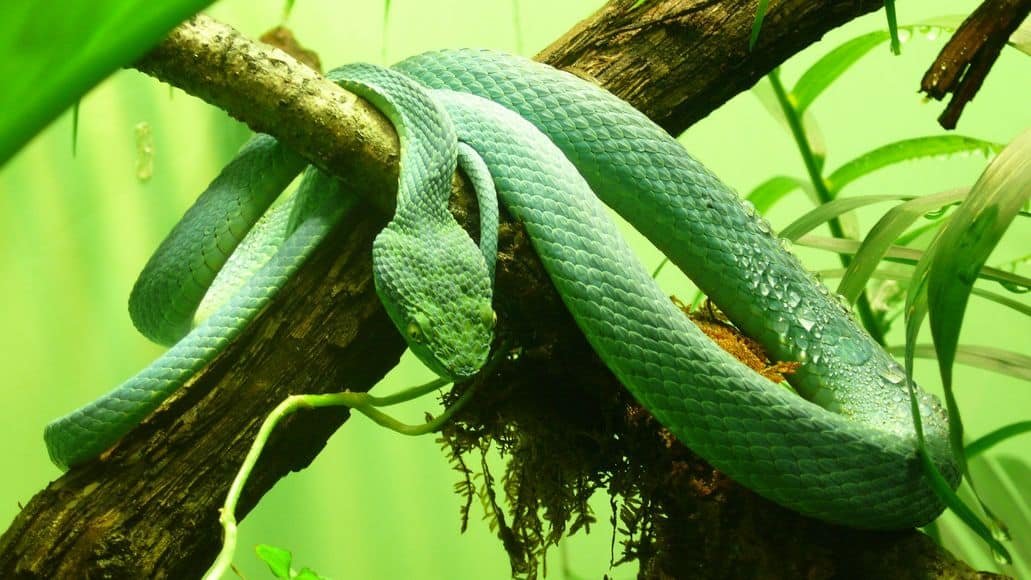
The Eyelash Viper is another venomous snake that is part of the pit vipers group. We will talk about it below in the section on yellow snakes.
South America
Two-Striped Forest Pit Viper
In the Amazon rainforest, you can find the the tree-climbing, 2-striped forest pit viper, sometimes known as the Amazonian palm viper. It has a pale green body and a yellow face. You don’t want to be bitten by one of these snakes as it can cause terrible swelling and uncontrolled bleeding.
Green Parrot Snake
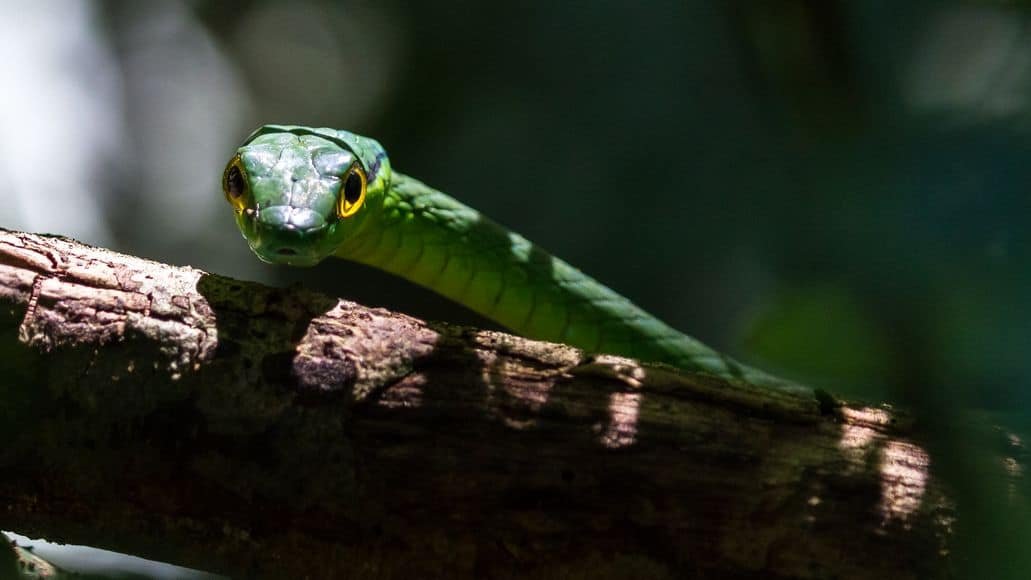
The green parrot snake is venomous, but not harmful to us or other mammals. It lives in Central and South America, from Mexico in the north to Argentina in the south. It is also called Lora and is distinguished by its large amber eyes and bright green scales that adorn its slender body.
Yellow Snakes
Most yellow snakes you see are albino versions of species that are not generally yellow. There are not too many snakes that are normally yellow. The most famous is the eyelash viper.
Eyelash Pit Viper
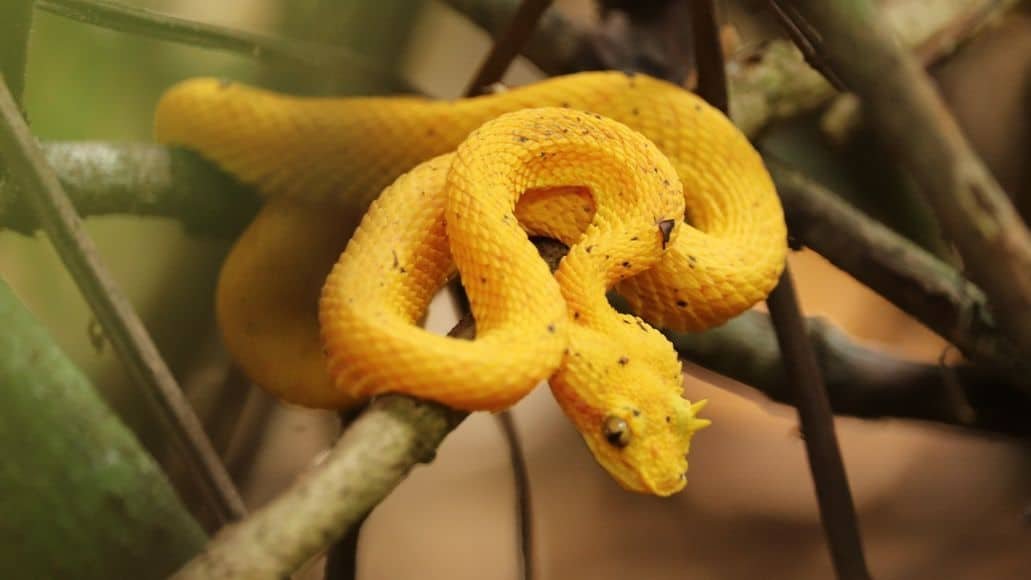
The Eyelash Viper is another venomous pit viper. They are found in parts of Mexico and South America. They’re live in jungles and mountain forests.
They reach about 32 inches in length and can be a brownish color or bright yellow. Like most snakes, they are carnivores, with a wide, triangular head.
Yellow And Green Snakes Aren’t Evil
Venomous or non-venomous, snakes are just innocently slithering around, making a meal of insects, spiders, rodents, etc. Whether or not the snake is potentially dangerous, you should never try to kill it.
Believe it or not, most snakes are harmless, and despite the fears that many people may have, snakes can be useful to have around in your garden. In fact, if you spot a snake in the wild or in your garden, you can count yourself lucky.
Just make sure to always keep your distance. This is particularly true if you’re unfamiliar with snakes. You certainly shouldn’t approach the snake to catch it. Just leave them alone. They play an important part in the food chain.
For Venomous Snakes, Call A Snake Whisperer
If you spot a green or yellow snake near your home and you know for sure, that it’s venomous snake, call a reputable snake expert to come to your home and remove the snake for you.
If you really don’t want snakes in your garden, keep your home, garden, and surroundings neat and tidy.
Snakes aren’t to be compared with rats or moles. They’re not something that requires getting rid of.
Rats infest an area and require getting rid of. Snakes are mostly solitary creatures and are actually useful, because they eat pests like rats.
Green And Yellow Snakes: Final Thoughts
Snakes are seriously misunderstood, even in the 21st century. Us humans put them under a lot of stress just because we hang on to the many myths about snakes that there are.
There are so many different species of snake and many of them can be distinguished by their color and patterns.
Some of the most beautiful are green and yellow snakes, most of which are non-venomous. But some of them look so similar to venomous ones that people easily become confused.
Best to keep your distance either way and just leave the snake alone. They aren’t malicious – they’re merely defending themselves from humans. Leave them alone and they will leave you alone, too.
Ivy Baker says
Over the past few months, I have noticed a lot of snakes in my garden. I liked that it would be smart to consider looking at the color of the snakes. Personally, I would want to hire an expert to help me with snake removal if there are dangerous snakes in my yard.
Gordon Wilson says
It’s generally the best course of action for most people.
linda says
Saw a green snake with white blotches in my back yard near SA,Texas art is.nd would like to know what kind it is> it came out of hiding when i turned on the water hose.